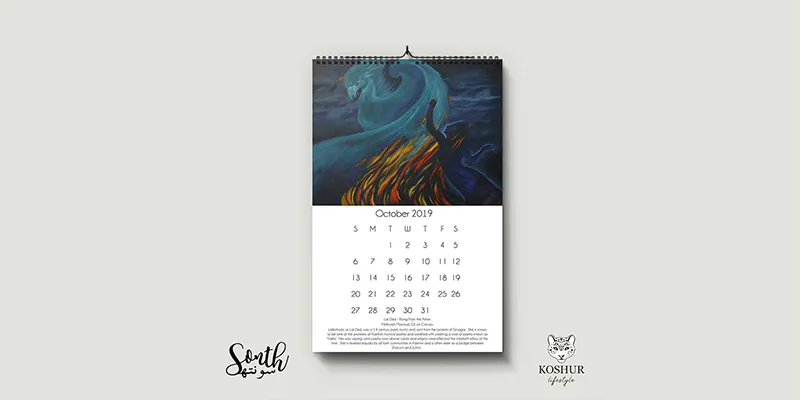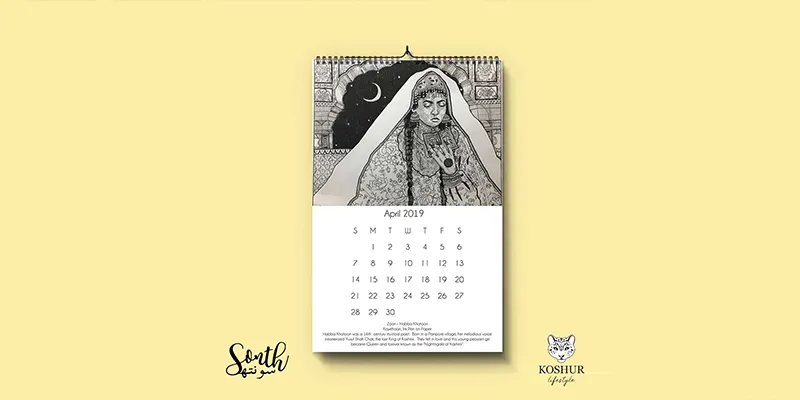How nine Kashmiri women came together to create a calendar depicting courage, hope and resilience
From Raj Begum, the first woman on Doordarshan Kashmir, to mystical poet Habba Khatoon, a new calendar created by nine Kashmiri women immortalises the women and culture of Kashmir in a riot of colours.
“If there is a heaven on earth, it’s here, it’s here, it’s here.”
Those are the words that Mughal emperor Jehangir used to describe Kashmir when he visited the Valley in the 17th century. But there is so much more to Kashmir than just its beauty. And trying to capture this essence by celebrating the culture and the women of this region is a calendar that has been put together by nine Kashmiri women.
“We live in a world where intolerance and hate is rampant and unity and love are, sadly, a rarity. Through this calendar, we wanted to show that a lot more can be and has been accomplished through love and respecting diversity. The contributions of these 12 women of Kashmir is a testament to this,” says Sama Bég, the Founder of Koshur Lifestyle, which offers contemporary clothing and accessories with a Kashmiri twist.
The calendar features notable Kashmiri women from Raj Begum, the first woman on DD Kashmir to the 14th-century saint Lal Ded.
It is a diverse mix of phenomenal women across different generations. and across fields that people can derive inspiration from.
The Kashmiri Women’s Design Collective
The calendar has been a dream come true for the Kashmiri Women’s Design Collective. Sama came across the work of Onaiza Drabu and Nusaiba Khan in August 2018. The latter had a stationery brand called Sonth and invited them to sell their products on her website. This collaboration led to the Kashmiri Women’s Design Collective after Onaiza succeeded in getting nine women together. One of the projects they undertook was a calendar for 2019. The aim was to celebrate the lives of inspirational Kashmiri women.
“We wanted a calendar that we could relate to and find inspiration from – a small tribute to a few of the women of Kashmir who have, in some way, had an impact on all our lives. What happened since was a serendipitous process of discovery and research. Each of us selected women from across the ages; women we resonated with and used different mediums of art to interpret their work and personalities. It also showed us how history has treated women unfairly and how important it is for us to retell those stories and correct those histories in any way we can.”

Women of Kashmir calendar
For centuries, women have played an important role in shaping Kashmiri culture. But very often, their contributions have not received the recognition they deserved and this is what this calendar celebrates. Says Sama,
In places of conflict, the voice and talent of the average person is often drowned out by the noise of violence. This endeavour is also an attempt to show the world that despite the many challenges we face in Kashmir, we have not - and never will - lose the desire to live and celebrate beauty,
“In addition to celebrating the women of Kashmir, these calendars also celebrate the beautiful religious diversity of Kashmir. My father has told me many stories about how close-knit communities here were when he was a child. He and my grandfather and their Pandit and Sikh friends often ate from the same plate and have maintained close ties till date," Sama explains.
She adds, "As someone who cherishes interfaith diversity and dialogue, I wanted to ensure that our calendars reflected this reality. Through hard work and help from the J&K Sikh Committee, we uncovered a Kashmiri Sikh lady by the name of Giyani Mohan Kaur who had made significant contributions for the upliftment of women during the partition. We also made it a point to recognise the work of a Christian missionary by the name of Muriel Mallinson. She selflessly contributed to transforming the education of women in Srinagar at The Mallinson Girls School.”

Some of the other women the calendar celebrates includes Queen Dida, who ruled Kasmir for 40 years from 979 to 1003 CE. Another historic figure to be featured in the calendar is Lad Ded, the 14th century mystic, saint and poet from the outskirts of Srinagar who has been a source of inspiration for many other Kashmiri poets.
Another mystical poet from the 16th century is Habba Khatoon and as Sama shares with us, she was popularly known as “Zoon” (the moon). Sama narrates how after a tragic marriage, Zoon found solace in poetry and singing. “One day, Zoon sang sitting under the shade of a Chinar tree when a gentleman on horseback approached – mesmerised by her melodious voice and beauty. The gentleman was none other than Yusuf Shah Chak, the last King of Kashmir. They fell in love and as fate would have it, this young peasant girl became Queen and was forever known for her soulful poetry as the “Nightingale of Kashmir”.
The list also includes Rupa Bhawani, a 17th-century saint and poet; Arnimal an 18th-century poet, and Raj Begum, an artist who paved the way for other Kashmiri women artists to enter the music industry.
There is also Dr Girija Dhar, a prominent gynecologist who started the first women’s hospital in the Valley, Hanifa Chapu, a gazetted officer who fought against corruption in the education sector, and Ateeqa Bano who after retiring in 1999 as State Director of Libraries & Research, went on to create Meeras Mahal, a private museum of history and art located in Sopore. Meeras Mahal is home to rare manuscripts, pottery and terracotta utensils, an entire history of the evolution of the Kashmiri pheran, and much more.
The reasonably priced calendar, available in both desk and wall versions, is a riot of colour. And as you flip through the pages, you are taken on a beautiful journey - one of hope, resilience, courage and history.







